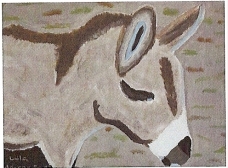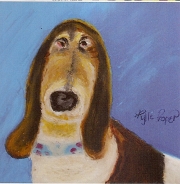“Model Animal” Program Brings Rewards to Teachers and Students Alike
 The “Model Animal” program, conceived of by Art for Animals, has proved a huge success in one school district in Columbia County, embraced by teachers and students alike. In the spring of 2009, the program was presented as a way to introduce the concept of compassion toward animals through art. The program succeeded in not only generating compassion and understanding toward animals, but also in bringing together diverse groups of students who otherwise might not have been friendly with each other.
The “Model Animal” program, conceived of by Art for Animals, has proved a huge success in one school district in Columbia County, embraced by teachers and students alike. In the spring of 2009, the program was presented as a way to introduce the concept of compassion toward animals through art. The program succeeded in not only generating compassion and understanding toward animals, but also in bringing together diverse groups of students who otherwise might not have been friendly with each other.
NYSHA President and middle-school teacher Laura-Ann Cammisa took the lead in bringing the “Model Animal” program to the art department at Taconic Hills Central Schools. Ms. Cammisa´s goal was to have live animals in art class once every quarter to serve as models. To establish the program, Ms. Cammisa first enlisted the support of the art teacher and then presented the idea to the principal. After gaining his approval, she engaged the cooperation of area residents and their well-socialized companion animals, adopted from shelters and rescue groups. Once chosen, the animal models needed to have a health clearance by the school administration to ensure they were disease free and up-to-date on shots.
 On the first “Model Animal” day, the subject was a Pit Bull named Grace, brought in by a local Pit Bull rescuer. Sadly, Grace´s ears had been cut off, as dog fighters cruelly do, to prevent another dog from grabbing them during a fight. The lack of ears prompted one sympathetic student to declare she was going to paint the dog with the ears it lacked, a sweet and compassionate observation and gesture.
On the first “Model Animal” day, the subject was a Pit Bull named Grace, brought in by a local Pit Bull rescuer. Sadly, Grace´s ears had been cut off, as dog fighters cruelly do, to prevent another dog from grabbing them during a fight. The lack of ears prompted one sympathetic student to declare she was going to paint the dog with the ears it lacked, a sweet and compassionate observation and gesture.
The following year, on one of the “Model Animal” days, the students participated in a field trip to Equine Advocates, a horse rescue organization in Columbia County, where students met various rescued horses. After learning the histories of the various horses, the students drew their personal impressions of them.
 This past year, Bellina, Ms. Cammisa´s big tortoise-shell cat became the first feline to appear in art class and Art Club. She was a big hit. The students stretched their skills and imaginations; some drew realistic representations while others were impressionistic.
This past year, Bellina, Ms. Cammisa´s big tortoise-shell cat became the first feline to appear in art class and Art Club. She was a big hit. The students stretched their skills and imaginations; some drew realistic representations while others were impressionistic.
 Though launched in the accelerated art class, the “Model Animal” program was extended to include art classes of other grade levels, as well as the after school Art Club, so every interested student could enjoy the thrill and challenge of working with an animal model. The individuals who brought the animals were glad to stay after school to encourage the budding artists.
Though launched in the accelerated art class, the “Model Animal” program was extended to include art classes of other grade levels, as well as the after school Art Club, so every interested student could enjoy the thrill and challenge of working with an animal model. The individuals who brought the animals were glad to stay after school to encourage the budding artists.
 According to Ms. Cammisa, the benefits of the “Model Animal” program were felt far beyond art class. She said, “The benefits were boundless. Animals brought kids together. Kids who did not get along would be united by an animal. On the days the animals were brought to school, a calming and socializing atmosphere was noticeable throughout the school.”
According to Ms. Cammisa, the benefits of the “Model Animal” program were felt far beyond art class. She said, “The benefits were boundless. Animals brought kids together. Kids who did not get along would be united by an animal. On the days the animals were brought to school, a calming and socializing atmosphere was noticeable throughout the school.”
 As far as academic relevance, Ms. Cammisa said that she used Bellina the cat in her Spanish class as a launching point for a Spanish lesson. After explaining that Bellina previously had been a homeless stray, she asked students to describe the characteristics and appearance of the cat now. This exercise provided the children with an opportunity to express compassion in a creative way, as well as expand their Spanish vocabulary. Ms. Cammisa said that when Spanish class ended, all her students lined up to say goodbye to Bellina, petted her gently and kissed her head.
As far as academic relevance, Ms. Cammisa said that she used Bellina the cat in her Spanish class as a launching point for a Spanish lesson. After explaining that Bellina previously had been a homeless stray, she asked students to describe the characteristics and appearance of the cat now. This exercise provided the children with an opportunity to express compassion in a creative way, as well as expand their Spanish vocabulary. Ms. Cammisa said that when Spanish class ended, all her students lined up to say goodbye to Bellina, petted her gently and kissed her head.
 Knowing that the students were interested in the cat model in school that day, the Math teacher used the opportunity to explain the concept of the geometric increase in class that day, an all too familiar phenomena that results from the mating of two unaltered cats.
Knowing that the students were interested in the cat model in school that day, the Math teacher used the opportunity to explain the concept of the geometric increase in class that day, an all too familiar phenomena that results from the mating of two unaltered cats.
 Though ArtforAnimals, the organization that created the concept, has unfortunately disbanded, the “Model Animal” program that was ignited at Taconic Hills by Ms. Cammisa, the principal, and the art department is flourishing and continues to engage children in compassion and love for animals.
Though ArtforAnimals, the organization that created the concept, has unfortunately disbanded, the “Model Animal” program that was ignited at Taconic Hills by Ms. Cammisa, the principal, and the art department is flourishing and continues to engage children in compassion and love for animals.
 Moreover, the benefits of the program need not be limited to Spanish and Math; they can extend to all classes in both an academic and social way. Discussing animals in class provides teachers with an opportunity that allows students to talk about their own animals which gives teachers an insight into the home life of students they might not otherwise have.
Moreover, the benefits of the program need not be limited to Spanish and Math; they can extend to all classes in both an academic and social way. Discussing animals in class provides teachers with an opportunity that allows students to talk about their own animals which gives teachers an insight into the home life of students they might not otherwise have.
 What you can do: Share this idea with your local schools and animal shelter directors, and rescue groups, so that it can be replicated in as many schools as possible throughout the state. The program is not expensive. The tools involved, the pencils, papers, and paints, would have been used in class regardless. But, by bringing animal models into the equation, the experience is much richer for the students, and the compassion and goodwill that is generated throughout the school is priceless.
What you can do: Share this idea with your local schools and animal shelter directors, and rescue groups, so that it can be replicated in as many schools as possible throughout the state. The program is not expensive. The tools involved, the pencils, papers, and paints, would have been used in class regardless. But, by bringing animal models into the equation, the experience is much richer for the students, and the compassion and goodwill that is generated throughout the school is priceless.
For further information about the program, you may contact Laura-Ann Cammisa at 845-336-4514.
New York State Humane Association Humane Review, Vol.XXV, No.3, Winter 2011-2012.